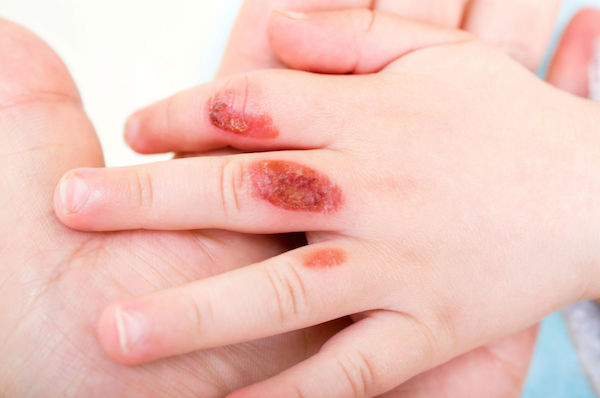Most often burns occur on the skin, the body’s protective barrier, but they can also affect other parts of the body including the layers of muscle and nerves below the skin.

The most common causes of burns are:
- Heat (such as fire, boiling water or steam)
- The sun
- Chemicals (including household and industrial chemicals)
- Friction
- Electricity
- Radiation
What are its symptoms?
Symptoms of burns will vary depending on the surface area covered and the depth of the burn.
They can include:
- Redness of the affected area. More significant burns may appear white or charred
- Blistering
- Pain, although the most severe burns may be painless due to nerve damage
- Inflammation
- Shock (indicated by pale, clammy skin, reduced alertness and weakness)
- Burns to the airways can lead to coughing and difficulty breathing
It is important that significant burns be treated promptly, as complications can include blood loss, infections, hypothermia, scarring and tetanus (also known as lockjaw, which sees painful muscle spasms occurring, particularly in the jaw and neck muscles).
How is it diagnosed?
Based on the source of the injury, it is often apparent whether you have been burned or not. However, there is a classification system for burns, depending on their severity:
- First degree burns affect the top layer of the skin, primarily causing redness, swelling and pain.
- Second degree burns are also called partial thickness burns as they extend to deeper skin layers, but don’t damage all the layers. They can lead to blistering, pain and inflammation.
- Third degree burns damage all the layers of the skin and appear white and stiff. They always require medical attention.
- Fourth degree burns extend into the underlying tissue and should be treated as a medical emergency.
What are your treatment options?
Treatment for burns depends on their location, extent and severity.
Running cool water over the affected area, applying a cold, wet compress and applying moisturising lotions can help soothe minor burns, as can over-the-counter painkillers.
Many second-degree burns can be treated at home by running cool water over the burn for 15 minutes (never use ice) and applying clean dressings to protect the wound.
More severe burns, as well as large second degree burns and burns to the face, hands, groin, buttocks or any major joints require medical attention. Treatment may include wound care, intravenous fluids, medication (antibiotics and painkillers) and surgery, such as skin grafts to close the wound.
Can it be prevented?
The National Burn Association of South Africa has a comprehensive list of behaviours that can prevent burns. Here are some of their tips:
- Install smoke detectors in your home
- Never overload electrical circuits
- Adjust geyser temperatures to avoid water becoming too hot
- Always unplug appliances that generate heat
- Discard cigarettes responsibly
- Never allow children to play with fireworks and never try to reignite fireworks that have malfunctioned
- Use sunscreen
- Remember to turn off paraffin stoves and lamps when they are not in use
- Keep gas heaters at least a metre away from anything flammable
- Don’t leave candles burning unattended.
For more info
The National Burn Association of South Africa
IMAGE CREDIT: 123rf.com
